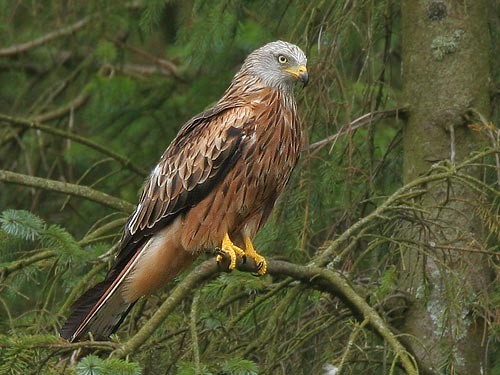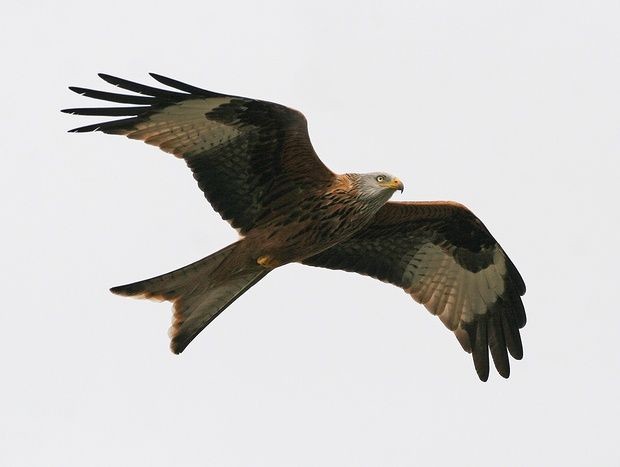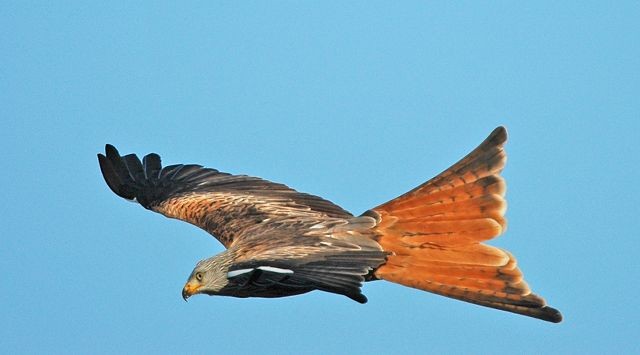A Kite's Tail - The Northern Kites Project
 |
| Red Kite: (photo: Steve Round). |
As BirdGuides users will know, Red Kites are magnificent, big, beautiful birds of prey. They were once common across Great Britain, probably being our most widespread bird of prey. Indeed, 300 years ago, the species would have been a common sight over much of lowland England and, in medieval times, it fed in the streets of London (where it was given special protection for its role in 'cleansing the streets'). Between the 16th and 19th centuries, Red Kites suffered severe persecution, with a consequent severe reduction in their numbers. By the end of the 19th century, just a handful of birds remained in Wales.
In 1989, to address the situation, a decision was taken by the Joint Nature Conservation Committee to reintroduce kites to various parts of the UK. Between 1989 and 2006 the RSPB, English Nature and a variety of other partners have been working on a programme to return Red Kites to their original British range. There had been six successful re-introduction schemes, three each in England and Scotland, and by 2002, northeast England had been identified as probably the last mainland location for such a reintroduction; 'joining the dots' between the projects further south and north.
Therefore Northern Kites was formed. The Project aims to re-introduce and, ultimately, re-establish the Red Kite as a breeding bird in northeast England. The timescale for the project is 2004-2008. In that period up to 80 kites will be released close to the heart of urban Tyneside - within three and a half kilometres of the Gateshead Metrocentre. In this respect, Northern Kites is unique in reintroducing Red Kites to a semi-urban environment.
The Project partnership, the lead partners being English Nature and the RSPB; also includes Gateshead Council, Northumbrian Water, The National Trust and the Forestry Commission, with additional funding from the Heritage Lottery Fund and the SITA Trust. As well as bringing the kite back to the northeast region, the partners are working to provide opportunities for people to see these spectacular birds.
 |
| Red Kite: (photo: Sean Gray). |
In essence, Northern Kites comprises four key elements:
- Wildlife - the return of the Red Kite to its former range in the region.
- People - the opportunity to give people and communities access to the kite, so that they can enjoy and learn about biodiversity and the wider environment.
- Economics - the chance to show how wildlife can be good not just for the environment and people, but also for the local economy.
- Partnership - to illustrate how partners from charitable, private and public sectors, working in an imaginative way, can deliver rewards not just for wildlife but also improve local people's quality of life.
At first glance, Gateshead might seem a strange choice for such a Project, but the area selected - in the lower Derwent valley - is right for a number of reasons. Firstly, the habitat mosaic is perfect for kites. Secondly, much of the land that the kites might use after release is already in the ownership, or management, of organisations that manage the land for nature conservation or heritage interest. Thirdly, and very importantly, the area is easily accessible to hundreds of thousands of people living in the Tyneside conurbation. It is worth remembering that Northern Kites is as much about people as it is the birds themselves. Whilst the northeast is well known for its rich natural heritage, many of the region's most exciting wildlife spectacles are remote from the region's main population. Northern Kites offers an exceptional opportunity to bring spectacular wildlife to the heart of the region and its people, on a daily basis.
In the northeast of England, kites have not bred for over 170 years. Now, they are back! The Northern Kites re-introduction schedule commenced in spring/summer 2004, when 20 kites were released. This gathered pace in 2005, when a further 41 joined them, with the final releases of translocated birds from the Chilterns population being planned for summer 2006.
It was always hoped that the kites released in 2004 might start indulging in some breeding activity in 2006. But they have exceeded expectations. Despite dreadful spring weather a pair have successfully hatched at least two chicks in a nest less than two miles from the Gateshead Metrocentre. Better still, the nesting site is just 120 metres from the Derwent Walk, where it crosses the Nine Arches Viaduct. This provides a perfect location for setting up a Kite Watchpoint to let the public see these brilliant birds. And, thanks to the efforts of Gateshead Council, that is exactly what has been done. The Watchpoint will be staffed everyday, until 30th July 2006, between 10am and 5pm. Information staff will be at the viaduct to assist people in viewing kite activities as the proud parents bring food to their nest. Although the nest is not visible, good views of the parents going about their business can be obtained through the day.
So a wildlife spectacle that has not been seen in northeast skies for almost six human generations is back for everybody to enjoy. Why not come along and enjoy it? Watch the skies!
Kite-watching at the Nine Arches Viaduct, Derwent Walk Country Park in Gateshead
How to get there:
- By car - from the A1 follow the A694 to the car park at Winlaton Mill Village c.NZ186609.
- By bus - take the 45, 46, 46a, 47 or 47a from Newcastle or the Metro Centre stopping at the Winlaton Mill car park. (Traveline telephone: 0870 6082608.)
For further information, telephone:
- Thornley Woodland Centre on 01207 545212.
- Northern Kites Office on 0191 4961555.
To reach the viaduct, follow the marked trail from the car park at Winlaton Mill (opposite the garage at the traffic lights) at c.NZ186609. It is approximately a 25-minute walk from the car park to the viaduct along a route that is accessible for wheelchair users and pushchairs.
 |
| Red Kite: (photo: Kev Joynes). |

